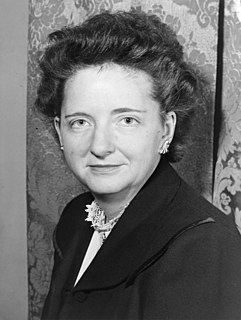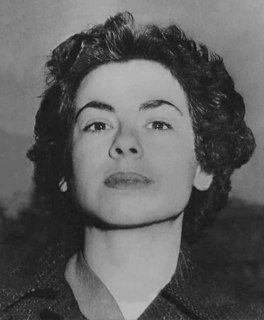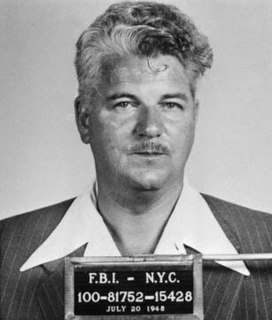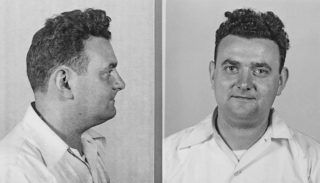 W
WCedric Henning Belfrage was an English film critic, journalist, writer, and political activist. He is best remembered as a co-founder of the radical US-weekly newspaper the National Guardian. Later Belfrage was referenced as a Soviet agent in the US intelligence Venona project, although it appears that he had been working for British Security Co-ordination as a double-agent.
 W
WElizabeth Terrill Bentley was an American spy and member of the Communist Party USA who served the Soviet Union from 1938 until 1945. In 1945, she defected from the Communist Party and Soviet intelligence by contacting the FBI and reporting on her activities.
 W
WEarl Russell Browder was an American political activist and leader of the Communist Party USA (CPUSA). Browder was the General Secretary of the CPUSA during the 1930s and first half of the 1940s.
 W
WWhittaker Chambers was an American writer-editor, who, after early years as a Communist Party member (1925) and Soviet spy (1932–1938), defected from the Soviet underground (1938), worked for Time magazine (1939–1948), and then testified about the Ware group in what became the Hiss case for perjury (1949–1950), often referred to as the trial of the century, all described in his 1952 memoir Witness. Afterwards, he worked as a senior editor at National Review (1957–1959). US President Ronald Reagan awarded him the Presidential Medal of Freedom posthumously in 1984.
 W
WVirginius Frank Coe was a United States government official who was identified by Soviet defectors Elizabeth Bentley and Whittaker Chambers as being an underground member of the Communist Party and as belonging to the Soviet spy group known as the Silvermaster ring.
 W
WLona Cohen, born Leontine Theresa Petka, also known as Helen Kroger, was an American who spied for the Soviet Union. She is known for her role in smuggling atomic bomb diagrams out of Los Alamos. She was a communist activist before marrying Morris Cohen. The couple became spies because of their communist beliefs.
 W
WMorris Cohen, also known by his alias Peter Kroger, was an American convicted of espionage for the Soviet Union. His wife Lona was also an agent. They became spies because of their communist beliefs.
 W
WJudith Coplon Socolov was a spy for the Soviet Union whose trials, convictions, and successful constitutional appeals had a profound influence on espionage prosecutions during the Cold War.
 W
WLauchlin Bernard Currie worked as White House economic adviser to President Franklin Roosevelt during World War II (1939–45). From 1949 to 1953, he directed a major World Bank mission to Colombia and related studies. Information from the Venona project, a counter-intelligence program undertaken by agencies of the United States government, references him in nine partially decrypted cables sent by agents of the Soviet Union. He became a Colombian citizen after the United States refused to renew his passport in 1954 due to doubts of his loyalty to the United States engendered by testimony of former Communist agents and information in the Venona decrypts.
 W
WFrancis Xavier Waldron, best known by the pseudonym Eugene Dennis and Tim Ryan, was an American communist politician and union organizer, best remembered as the long-time leader of the Communist Party USA and as named party in Dennis v. United States, a famous McCarthy Era Supreme Court case.
 W
WBolesław Konstanty "Bill" Gebert was a top Communist Party official, remembered as one of the organization's top Polish-language speaking leaders. He was a Soviet agent during the years of World War II and was an official of the Polish Communist government after the war.
 W
WDavid Greenglass was an atomic spy for the Soviet Union who worked on the Manhattan Project. He was briefly stationed at the Clinton Engineer Works uranium enrichment facility at Oak Ridge, Tennessee, and then worked at the Los Alamos Laboratory in New Mexico from August 1944 until February 1946.
 W
WTheodore Alvin Hall was an American physicist and an atomic spy for the Soviet Union, who, during his work on US efforts to develop the first and second atomic bombs during World War II, gave a detailed description of the "Fat Man" plutonium bomb, and of several processes for purifying plutonium, to Soviet intelligence. His brother, Edward N. Hall, was a rocket scientist who worked on intercontinental ballistic missiles for the United States government.
 W
WAlger Hiss was an American government official accused in 1948 of spying for the Soviet Union in the 1930s. Statutes of limitations had expired for espionage, but he was convicted of perjury in connection with this charge in 1950. Before the trial he was involved in the establishment of the United Nations both as a U.S. State Department official and as a U.N. official. In later life he worked as a lecturer and author.
 W
WFiorello Henry La Guardia was an American politician. He is best known for being the 99th Mayor of New York City for three terms from 1934 to 1945 as a pro-New Deal liberal progressive Republican. Previously he had been elected to Congress in 1916 and 1918, and again from 1922 through 1930. Irascible, energetic, and charismatic, he craved publicity and is acclaimed as one of the greatest mayors in American history. Only five feet, two inches tall, he was called "the Little Flower".
 W
WBoris Morros was an American Communist Party member, Soviet agent, and FBI double agent. He also worked at Paramount Pictures, where he produced films as well as supervising their music department.
 W
WNicholas W. Orloff (1890s-1961) was a Russian immigrant to the United States and an agent of the New York KGB during World War II. According to historian John Earl Haynes and Harvey Klehr's analysis of the Venona Cables, Orloff received a regular stipend from the KGB for his services, reporting information on immigrant groups to Soviet intelligence and acting as a talent-spotter for new sources. He also appeared on the August 17, 1958 episode of What's My Line?, where he is credited as a "United Nations Interpreter."
 W
WFranklin Delano Roosevelt, often referred to by his initials FDR, was an American politician who served as the 32nd president of the United States from 1933 until his death in 1945. A member of the Democratic Party, he won a record four presidential elections and became a central figure in world events during the first half of the 20th century. Roosevelt directed the federal government during most of the Great Depression, implementing his New Deal domestic agenda in response to the worst economic crisis in U.S. history. As a dominant leader of his party, he built the New Deal Coalition, which defined modern liberalism in the United States throughout the middle third of the 20th century. His third and fourth terms were dominated by World War II, which ended shortly after he died in office.
 W
WJack Soble was a Lithuanian who, together with his brother Robert Soblen, penetrated Leon Trotsky's entourage for Soviet intelligence in the 1920s. Later, in the United States, he was jailed together with his wife Myra on espionage charges. He was born in Vilkaviskis, Lithuania as Abromas Sobolevicius and sometimes used the name Abraham Sobolevicius or Adolph Senin.
 W
WAnna Louise Strong was an American journalist and activist, best known for her reporting on and support for communist movements in the Soviet Union and the People's Republic of China. She wrote over 30 books and varied articles.
 W
WHarry Dexter White was a senior U.S. Treasury department official. Working closely with the Secretary of the Treasury Henry Morgenthau, Jr., he helped set American financial policy toward the Allies of World War II. He was later accused of espionage by passing information to the Soviet Union.
Mark Zborowski was an anthropologist and an NKVD agent. He was the NKVD's most valuable mole inside the Trotskyist organization in Paris during the 1930s and in New York during the 1940s.